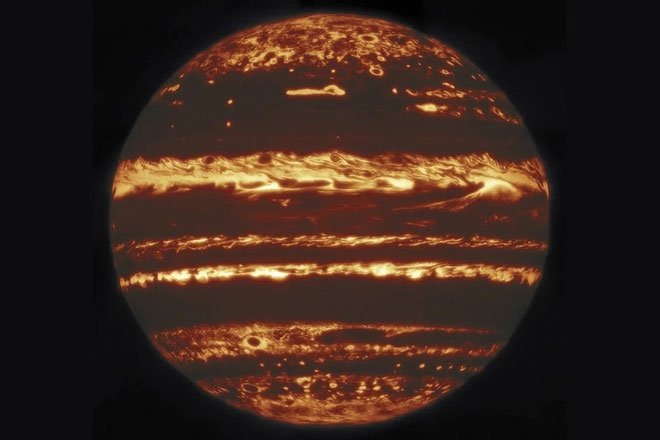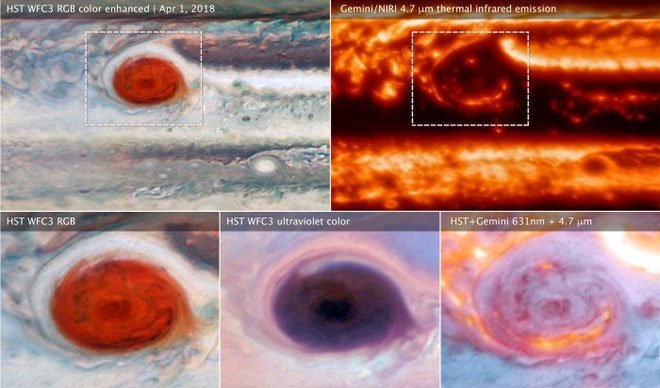The image solving the largest planetary mystery
As the largest planet in the Solar System, Moc Tinh from afar looks like a peaceful planet with colorful patterns and lines surrounding it.
In fact, Moc Tinh is not so peaceful. This giant gas planet is covered by violent storms around the globe with a depth many times thicker than the atmospheric distance between Earth and space.
With extremely severe weather patterns, Moc Tinh research projects have always made astronomers very hard to find out.

High-resolution photos help solve many of Jupiter's mysteries. (Photo: International Gemini Observatory).
In a paper published in The Astrophysical Journal Supplement Series, scientists showed us spectacular images of Jupiter's high-resolution Jupiter telescopes and telescopes for the first time. Hubble space.
'The planet looks like a ghostly fire. The dark areas in the image correspond to areas with a lot of stormy clouds, while the areas with infrared light represent areas without clouds, ' says astronomer Michael Wong of the University of California, Berkeley.
The dark areas of the image include a curving line around the edge of the Great Red Spot. Referring to Jupiter, there may not be many people who know the Great Red Spot - a massive fiery storm larger than the Earth that is believed to have existed for hundreds of years and shows no signs of stopping.
'It is difficult to distinguish the material clouds and thinner clouds that cover Jupiter's interior through light observation, which is still a mystery to us' - planetary scientist Glenn Orton JET test by NASA.
Thanks to the images collected, scientists have had the opportunity to solve that mystery. When comparing the two images, a glowing infrared arc matched an optical shadow, showing that the color marked a deep crack inside storm clouds.

When combined with images taken from NASA's Juno satellite, scientists explained the origin of lightning on Jupiter. (Photo: NASA).
In addition, data collected from NASA's Juno satellite orbiting Jupiter revealed radio signals in the atmosphere originating from lightning strikes. During the first 8 flights, Juno's microwave radiometer detected 37 lightning discharges, concentrated around the planet's polar regions. This phenomenon is in contrast to Earth, where lightning storms gather around the equator.
"Data from the Hubble and Gemini telescopes could help us gather more information about these clouds," said planetary scientist Amy Simon of NASA.
The team found lightning strikes were created in areas with large humid air towers, convective on clouds in both frozen and liquid forms. Clear areas around these storms form a drier airflow outside the convection cells.
"These tornadoes can contain the flow of energy within, helping to release energy through convection. It doesn't take place everywhere and it seems that something has facilitated this convection." , explained Simon further.
But the mission for Juno will continue and is expected to end in July 2021. With the function equivalent to weather satellites, combined with the data images captured on Earth, it is very likely that in the future, the harsh climate model of Moc Tinh will be solved by scientists.
- The mystery of the crazy lightning storms on Jupiter has solved!
- Video: Super typhoon The big red spot on Jupiter shrinks and changes color
- The Hubble Space Telescope records images of dying stars
- 1.5 Gigapixel image to Andromeda galaxy with over 100 million stars
- Capture the world's largest satellite image missing
- Planetary nebula
- Discover new planetary system formed in the universe
- Find a new planetary system containing 3
- Strange planetary system has 3 'Venus'
- Record the image of the world's largest blue whale
- The clearest picture of the sun flare
- Detecting inclined planetary system
- Discover the 168-year mystery of the largest volcanoes in Hawaii
- The mystery of the world's largest sailing ship
 Van Allen's belt and evidence that the Apollo 11 mission to the Moon was myth
Van Allen's belt and evidence that the Apollo 11 mission to the Moon was myth The levels of civilization in the universe (Kardashev scale)
The levels of civilization in the universe (Kardashev scale) Today Mars, the sun and the Earth are aligned
Today Mars, the sun and the Earth are aligned The Amazon owner announced a secret plan to build a space base for thousands of people
The Amazon owner announced a secret plan to build a space base for thousands of people Which planet is the largest in the Solar System?
Which planet is the largest in the Solar System?  Which planet is the oldest and youngest in the Solar System?
Which planet is the oldest and youngest in the Solar System?  Arranged in strange shapes, giant tornadoes on Jupiter leave scientists stunned
Arranged in strange shapes, giant tornadoes on Jupiter leave scientists stunned  Tonight 'The paradoxical Earth' has life appearing, how to observe?
Tonight 'The paradoxical Earth' has life appearing, how to observe?  How many moons does Jupiter have?
How many moons does Jupiter have?  Encounter Jupiter's elusive 5th moon
Encounter Jupiter's elusive 5th moon 